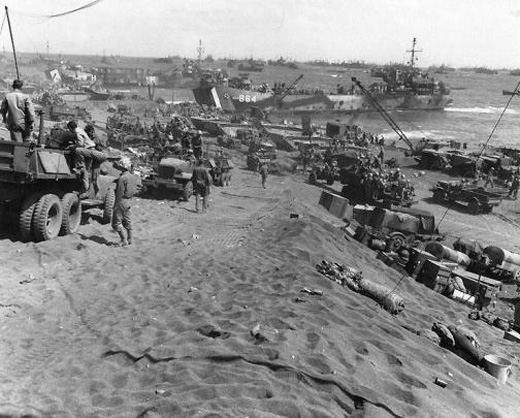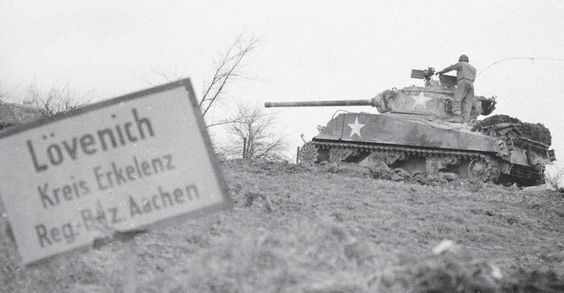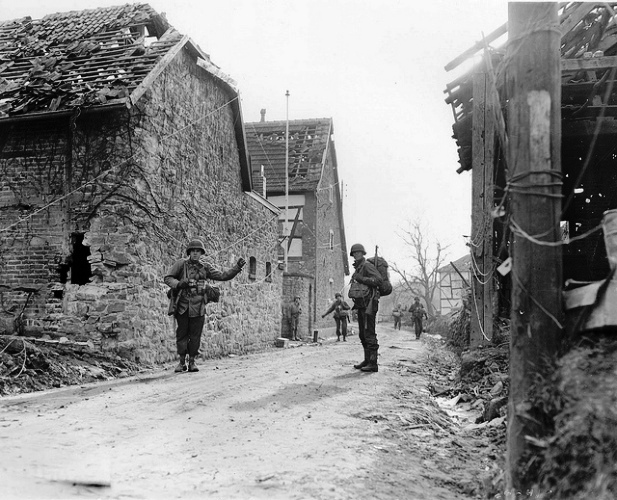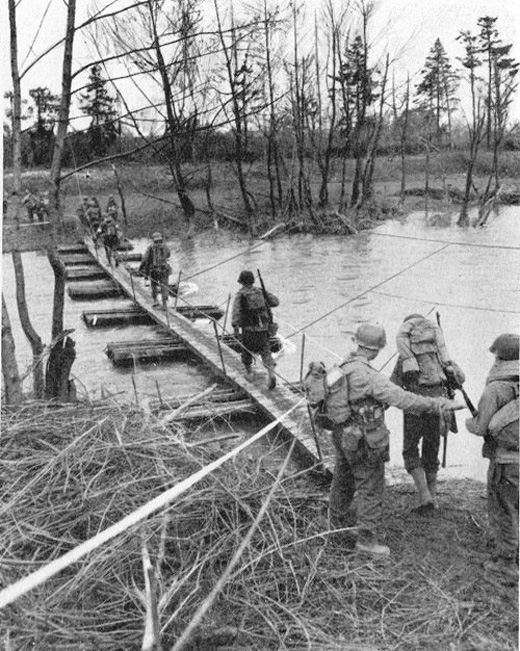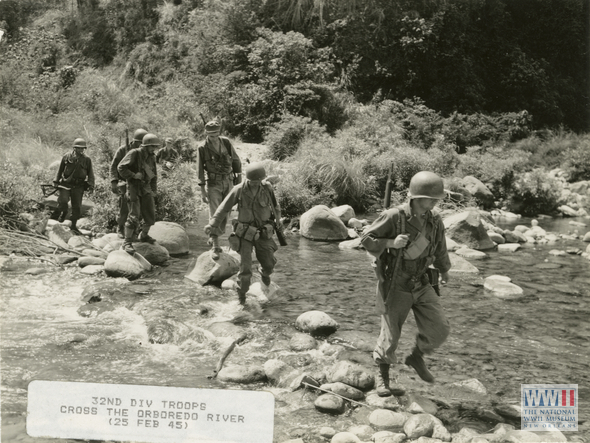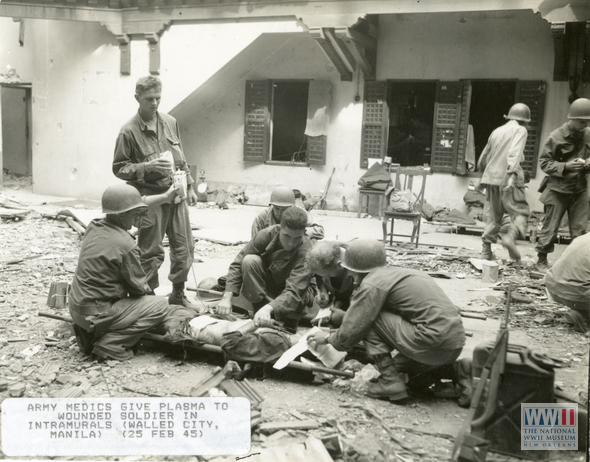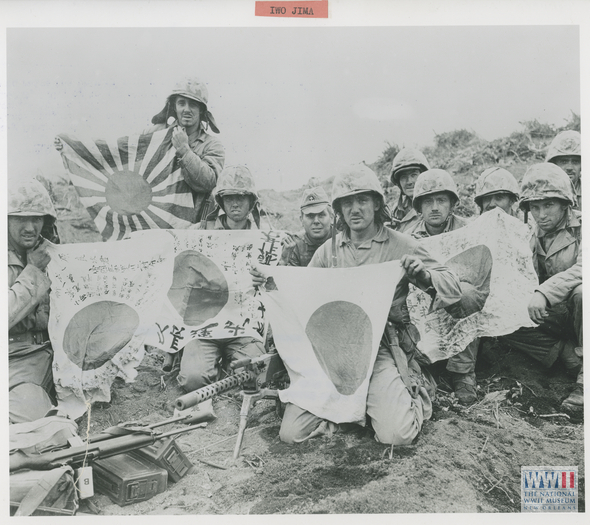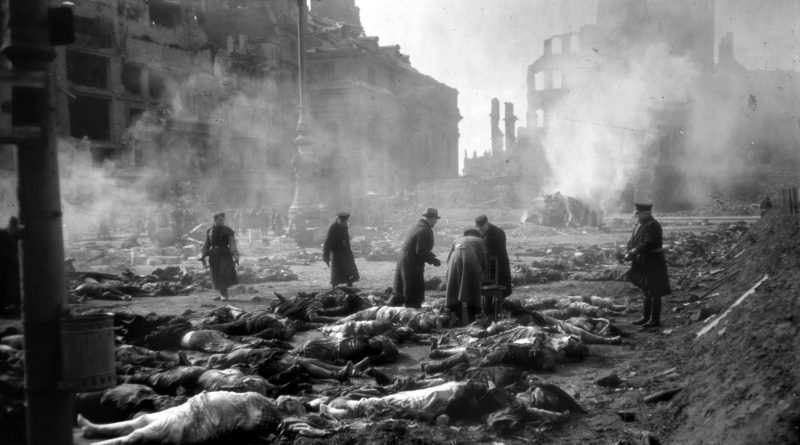Air Operations, CBI
BURMA- 9 10th Air Force B-25s and 85 fighter-bombers attack troops and numerous other targets behind Japanese Army battle lines.
- A B-25 attacks a bridge at Namsang.
- 31 P-47s support Chinese Army ground forces around Lashio and Namtu.
- 16 P-47s support British 14th Army ground forces in the Mongmit area.
- 4 308th Heavy Bomb Group B-24s attack shipping in the South China Sea.
- 6 341st Medium Bomb Group B-25s and 5 14th Air Force P-51s attack buildings and sampans in the Puchi area.
- 3 B-25s and 19 fighter-bombers attack a ferry at Isuho and road and river traffic between Hengyang and Siangtan.
- 1 B-25 attacks a road convoy near Hengyang.
- 44 P-40s and P-41s attack numerous other targets.
- 475th Fighter Group P-38s down 2 A6M2-N 'Rufe' float planes over Camranh Bay at 1140 hours.
Air Operations, East Indies
XIII Bomber Command B-24s attack the Labuan and the Tawau airfields on Borneo.
[Air Operations, Europe
RAF BOMBER COMMANDDaylight Ops:
- 153 Lancasters of No. 3 Group carry out a G-H attack on the synthetic oil refinery at Kamen.
- 1 Lancaster is lost.
Minor Ops:
- 63 Mosquitos are sent to Erfurt, 10 each to Berlin and Mainz, and 6 to Bremen, 10 Halifaxes of No. 6 Group lay mines in Oslo Fjord, 20 aircraft are on Resistance flights, and there are 23 Mosquito patrols and 8 RCM sorties.
- 1 mine-laying Halifax is lost.
GERMANY:
- 247 1st Air Division B-17s attack rail targets at Munich.
- 63 1st Air Division B-17s attack tank factory at Friedrichshafen.
- 51 1st Air Division B-17s attack a marshalling yard at Ulm (secondary).
- 115 2nd Air Division B-24s attack a marshalling yard at Aschaffenburg.
- 54 2nd Air Division B-24s attack a tank factory at Aschaffenburg.
- 189 2nd Air Division B-24s attack the Giebelstadt and Schwabisch Hall jet airdromes.
- 315 3rd Air Division B-17s attack a marshalling yard at Munich.
- 88 3rd Air Division B-17s attack the town of Neuberg.
- 35 heavy bombers attack various targets of opportunity.
- 5 B-17s and 8 of 442 VIII Fighter Command escorts are lost.
GERMANY:
- 9th Air Division bombers attack rail bridges, marshalling yards, communications centers, and targets of opportunity.
- 8th and 9th Air Force fighter pilots down 30 Luftwaffe aircraft over Germany between 0815 and 1115 hours.
ITALY:
- 12th Air Force B-25s attack bridges at four locations and a rail fill.
- XXII TAC P-47s attack rail targets, motor vehicles, and dumps.
- During the night, XXII TAC A-20s and A-26s attack marshalling yards at two locations.
AUSTRIA:
- More than 600 15th Air Force B-17s and B-24s attack six marshalling yards at four locations, a synthetic-fuel plant at Linz, an ordnance depot, and targets of opportunity.
Air Operations, Formosa
- V Fighter Command P-51s attack targets of opportunity in eastern Formosa.
- A 35th Fighter Group P-47 downs a Ki-46 'Dinah' reconnaissance plane near Formosa at 1830 hours.
Air Operations, Japan
- In the XXI Bomber Commandís largest mission to date, 172 73rd and 313th Very Heavy Bomb wing B-29s attack Tokyo city areas with 454 tons of incendiary bombs. 30 other B-29s attack alternates and targets of opportunity. Approximately 1 square mile of the Tokyo city area is burned out.
- 3 B-29s are lost.
- Despite bad weather, Task Force 58 carrier aircraft attack targets throughout the Tokyo area. An estimated 150 Japanese aircraft are destroyed on the ground, 5 small vessels are sunk, several airfields are damaged, and 2 aircraft factories are disabled.
- 9 US carrier aircraft are lost with 4 of their pilots.
- US carrier-based F6Fs and F4Us down 46 Japanese aircraft over the Tokyo area between 0850 and 1040 hours, and US Marine Corps carrier-based F4Us down 7 Japanese fighters over Tokyo Bay and the Kumagaya airfield on Honshu between 0930 and 1015 hours.
- The XXI Bomber Commandís test of incendiary bombing of a Japanese city is deemed so successful that it is decided on short notice to dedicate the 20th Air Force to incendiary missions against civilian targets rather than the planned program of precision daylight missions against industrial targets.
Air Operations, Pacific
- 334 B-29 Superfortresses of XXI Bomber Command of the US Air Force carry out a heavy raid on Tokyo dropping 1,667 tons of incendiary bombs. The Americans pass on from precision bombing of military targets by day to carpet bombing of the big residential centers. 15 square miles of the Japanese capital is destroyed.
- Carrier-borne aircraft from Vice-Adm Mitscher's squadron of fast carriers also attack airfields and aircraft factories near Tokyo. These very heavy raids are repeated the next day.
Air Operations, Philippines
FEAF B-24s attack Japanese Army ground troops in the Ipo River area.
[Air Operations, Volcano Islands
- Task Group 52.2 TBMs and FMs provide support for US V Marine Amphibious Corps ground forces on Iwo Jima.
- 9 VII Bomber Command B-24s support V Marine Amphibious Corps ground troops with an attack against blockhouses and mortar and rocket positions in northwestern Iwo Jima.
- During the night, a VC-92 antisubmarine TBM from the USS Tulagi sinks a Japanese submarine.
Burma
The 17th Indian Div, British IV Corps, take Mahlaing.
[Eastern Front
The Vistula Army Group counterattacks northwest of Arnswalde, south of Stettin toward Pyritz, but although some success is achieved its effect is only local and temporary. Sharp street fighting develops in Breslau.
CENTRAL SECTORThe 19th Army rips a 35-mile hole in the right wing of the 2nd Army and advances 30 miles toward Koslin. Danzig and the entire 2nd Army are threatened with isolation by this new advance.
[Italy
In the US 5th Army sector the first stage of the IV Corps' limited offensive west ot Highway 64 is concluded.
On the right of the Allied front, the first units of the Italian Folgore combat group take up positions in the XIII Corps, British 8th Army, sector; by March 3 the Italian troops will have completed their deployment astride the Santerno River, taking over responsibility for the sector previously held by the British 6th Div.
[Iwo Jima
Bold action by units of the 3rd Marine Div enables them to capture almost the whole of Airfield No. 2. However, the Japanese continue to resist most fiercely from 3 positions known as Height 382, Amphitheater and Turkey Ridge. The fighting is ferocious; the Americans have dubbed the area the 'Mincer', and rightly so. During the day and the next night, Japanese fire knocks out 20 Sherman tanks. Mount Suribachi is officially declared captured.
The attack transport Fayette (APA-43) and the attack cargo ship Muliphen (AKA-61) are both damaged in a collision. The seaplane tender Hamlin (AV-15) is damaged accidentally by US naval gunfire.
[Pacific
- The US destroyer Harrison (DD-573) is damaged during a storm south of Honshu, Japan.
- The US motor minesweeper YMS-275 is damaged when it hits a mine in the Caroline Islands area.
- The US destroyers Hazelwood (DD-531) and Murray (DD-576) sink Japanese guardboats No.1 Fuju Maru, Koki Maru and Seion Maru off Tori Jima.
- The US submarine Flasher (SS-531) sinks the Japanese cargo ship Koho Maru (850t) near Hainan.
- The US submarine Hoe (SS-258) attacks a Japanese convoy south of Hainan Island and sinks the escort vessel Shonan.
- The US submarine Piper (SS-409) sinks the Japanese guardboat No.3 Hosen Maru east of Kaikou in the South China Sea.
- The British submarine Trenchant attacks a Japanese convoy in South Malacca Strait and sinks the cargo vessel No.9 Akiyama Maru.
Philippines
On Luzon the US XIV Corps prepares to liquidate the last nests of Japanese resistance in Manila. There is further American progress in the island of Corregidor.
In Manila the 37th Infantry Division captures Intramuros.
In the XI Corps area the 40th Infantry Division eliminates all Japanese resistance west of Fort Stotsenburg.
[Western Front
The 53rd Div, British XXX Corps, Canadian 1st Army, comes within about a mile and a quarter of Weeze, and is ordered to halt there.
The 35th Div of the US XVI Corps, 9th Army, and armored units of the 5th Arm Div of the XIII Corps begin crossing the Rur opposite Linnich and south of Hottorf. On the army's right flank the XIX Corps also continues to advance and its units reach Müntz and Rodingen. In the US 1st Army sector the VII Corps completes the capture of Düren, then reaching the line of the bridgehead, while the 1st Div begins operations for crossing the Rur.
The offensive of the US 3rd Army continues and units of the 4th Arm Div, after crossing the Prüm River near Hermesdorf, succeed in establishing a bridgehead over the Nims at Rittersdorf. In the XX Corps sector units of the 10th Arm Div cross the Saar near Taben and advance toward Zerf.
[Images from February 25, 1945
|
|
|
|
|
|
|
|
